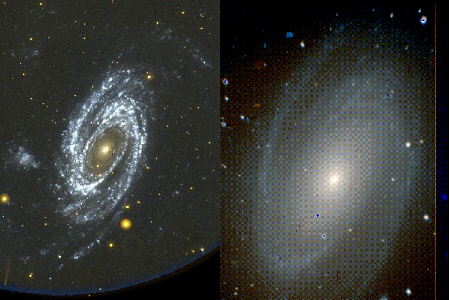

Galactic Surprise
by Patrick L. Barry and Dr. Tony Phillips
Open an old astronomy textbook. The basic sketch you'll find there of galaxy formation is fairly simple: a vast cloud of diffuse hydrogen and helium gas condenses under gravity, and dense spots in the cloud collapse to form stars. Voila! A galaxy.
But real galaxies are much more complex than that. A galaxy is a swirling "soup" of billions of stars and roaming black holes, scattered clouds of gas and dust, random flashes of star birth and exploding supernovas, and an unseen and mysterious substance called "dark matter." Over time, all these ingredients mix and interact-pulling and compressing and colliding-and somehow that interplay leads to the galaxies we see today. No wonder it's such a hard problem to solve!
Just over one year into its three-year mission, GALEX is already shedding some new light on the problem.
"Some of the discoveries GALEX has made will change our understanding of how galaxies develop and when, where, and why stars form in galaxies," says Peter Friedman, a researcher at Caltech and Project Scientist for GALEX.
This small space telescope, called the Galaxy Evolution Explorer (GALEX for short), makes its discoveries by taking pictures of millions of galaxies scattered over the whole sky. Some of these galaxies are close by (at least by astronomical standards of "close"), while others are as much as 10 billion light-years away. Because light takes time to travel through space, we see these distant galaxies as they appeared billions of years ago. Comparing young galaxies from the distant past with older, modern galaxies will teach scientists about how galaxies change over time.
Looking at these pictures, scientists were surprised to find many newborn stars in the outer parts of old, mature galaxies. Scientists had assumed that as a galaxy ages, the clouds of gas needed to form new stars in these outer reaches either got used up or blown away. Finding so many new stars in these regions of old galaxies (such as Centaurus A, Messier 101, and Messier 81) shows that, apparently, they were wrong.
Friedman says that astronomers don't know yet how to explain these new findings. Rethinking and improving theories to explain unexpected discoveries has always been the way science makes progress-and GALEX is certainly making progress.
One thing is certain: It's time to re-write some old textbooks.
For more information, see http://www.galex.caltech.edu/ . Kids can do a galaxy art project and learn more about galaxies and GALEX at http://spaceplace.nasa.gov/en/kids/galex/art.shtml .
M81 is 10 million light years away. The image on the left was made from GALEX data and shows UV light from hot, new stars. These star forming regions are not detectable in the visible light image on the right (McGraw-Hill Observatory, Kitt Peak, Arizona, Greg Bothum, Univ. of Oregon.)
This article was provided by the Jet Propulsion Laboratory, California Institute of Technology, under a contract with the National Aeronautics and Space Administration.
All content is the responsibility of LUNAR.
If you have comments or suggestions regarding these web pages,
please contact the 
Copyright © 1992 - 2025 LUNAR